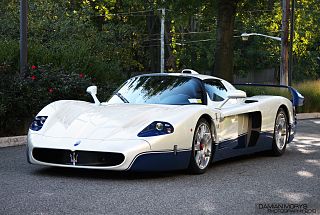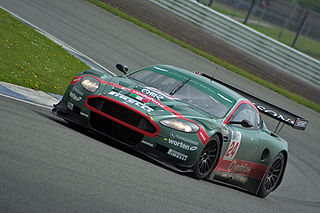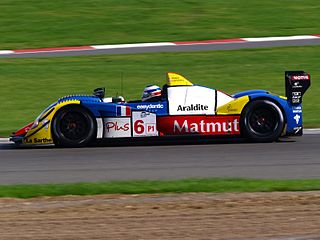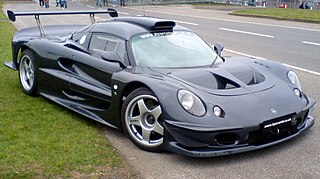
Sports car racing is a form of motorsport road racing which utilises sports cars that have two seats and enclosed wheels. They may be either purpose-built sports prototypes which are the highest level in sports car racing or grand tourers based on road-going models and therefore, in general, not as fast as sports prototypes. Sports car racing is one of the main types of circuit auto racing, alongside open-wheel racing, touring car racing and stock car racing. Sports car races are often, though not always, endurance races that are run over particularly long distances or large amounts of time, resulting in a larger emphasis on the reliability and efficiency of the car and its drivers as opposed to outright car performance or driver skills. The FIA World Endurance Championship is an example of one of the best known sports car racing series.

The Maserati MC12 is a limited production two-seater sports car produced by Italian car maker Maserati from 2004 to 2005, to allow a racing variant to compete in the FIA GT Championship. The car entered production in 2004, with 25 cars produced. A further 25 were produced in 2005 after the FIA changed the rules and reduced the maximum length allowed. The second batch of 25 are 150mm shorter than the originals, making a total of 50 cars available for customers. With the addition of 12 cars produced for racing, a total of just 62 were ever produced.

Érik Gilbert Comas is a French former racing driver. He was the French Formula 3 champion in 1988, and then Formula 3000 champion in 1990, after scoring the same number of points as Jean Alesi in 1989, but losing on a count-back of positions. He participated in 63 Formula One Grands Prix between 1991 and 1994, scoring a total of seven championship points. His last point, in the 1994 German Grand Prix, was also the last one for the Larrousse team. After his F1 career, he won the All-Japan GT Championship for Nismo in the top GT500 class in 1998 and 1999.

BMS Scuderia Italia SpA is an auto racing team founded in 1983 in Brescia by Italian businessman and motorsports enthusiast Giuseppe Lucchini. Originally named Brixia Motor Sport (BMS), the team initially competed in the World Touring Car Championship. The team's name was altered to BMS Scuderia Italia upon their entrance into Formula One in 1988. After departing Formula One in 1993, BMS Scuderia Italia has continued to be involved in other categories such as touring car racing and sports car racing.

The Lister Storm was a homologated GT racing car manufactured by British low-volume automobile manufacturer Lister Cars with production beginning in 1993.

The Aston Martin DBR9 is a racing car built by Aston Martin Racing, debuting in 2005 and racing actively in international sportscar racing until the end of GT1 category in 2011. The name DBR9 is derived from the original 24 Hours of Le Mans-winning DBR1 car, named for then-owner David Brown, which not only won the 24 Hour race in 1959 but also the World Sportscar title. The car is most famous for taking two LMGT1 class wins at Le Mans 24 Hours by the Aston Martin Racing factory team.

Courage Compétition was a racing team and chassis constructor company now owned by Oreca, based in Le Mans, France, near the Circuit de la Sarthe. It was founded by Yves Courage, a French race driver who ran hillclimbs before founding the company. Following the purchase of Courage by Oreca in 2007, Yves Courage has refounded the company as Courage Technology in 2010, attempting to develop electric racing cars.

The McLaren F1 GTR is the racing variant of the McLaren F1 sports car first produced in 1995 for grand touring style racing, such as the BPR Global GT Series, FIA GT Championship, JGTC, and British GT Championship. It was powered by the naturally aspirated BMW S70/2 V12 engine. It is most famous for its overall victory at the 1995 24 Hours of Le Mans where it won against faster purpose-built prototypes in very wet conditions. The F1 GTR raced internationally until 2005 when the final race chassis was retired.

The Lotus Elise GT1 is a race car developed for grand tourer-style sports car racing starting in 1997.

The Chevrolet Corvette C6.R is a grand tourer racing car built by Pratt Miller and Chevrolet for competition in endurance racing. It is a replacement for the Corvette C5-R racing car, applying the body style of the new C6 generation Chevrolet Corvette as well as improvements to increase the speed and reliability on the track. Since its debut in 2005, it has continued on from the previous dominance of the C5-R in its racing class with multiple American Le Mans Series championships and race wins in the Le Mans Series, FIA GT Championship, and 24 Hours of Le Mans. There are two main versions of the Corvette C6.R: the GT1 version which has 590 HP, carbon-ceramic brakes, and aggressive aerodynamics, and the GT2 version which has 470 HP, cast-iron brakes, and relatively stock aerodynamics with respect to the road car. Unrestricted though, the LS7.R engine will produce around 800 hp. By 2012 the C6.R GT1 was retired from the competition while the GT2 version continues to race around the world.

Jamie Oliver Campbell-Walter is a British professional racing driver. He was born in Oban, Scotland on 16 December 1972. He won the FIA GT Championship in 2000 and took a World Endurance Championship title in 2013 as an Aston Martin Racing factory driver. He now owns and runs Bullet Sports Management with business partner and former team-mate Nicolas Minassian and María Catarineu.

The Chrysler Viper GTS-R was a successful racing variant of the Dodge Viper developed in conjunction with Chrysler of North America, Oreca of France and Reynard Motorsport of the United Kingdom. Officially unveiled at the 1995 Pebble Beach Concours, it has won numerous championships and famous events in its history.

Reiter Engineering GmbH & Co Kg, commonly known simply as Reiter Engineering, is a German racing team and racing car manufacturer established in 2000 by motorsport engineer Hans Reiter.

Champion Racing was a sports car racing team based in Pompano Beach, Florida, USA. Founded in 1994 by Dave Maraj, a former rally driver from Trinidad, as the motorsport wing of the Champion Motors car dealership, the team has campaigned various Porsches and Audis in North American road racing series. Champion Racing's extensive record includes a win at the prestigious 24 Hours of Le Mans in 2005, and 5 straight American Le Mans Series LMP1 championships, 2 as a private team and 3 as a factory team under the name Audi Sport North America.

Group GT3, known technically as Cup Grand Touring Cars and commonly referred to as simply GT3, is a set of regulations maintained by the Fédération Internationale de l'Automobile (FIA) for grand tourer racing cars designed for use in various auto racing series throughout the world. The GT3 category was initially created in 2005 by the SRO Motorsports Group as a third rung in the ladder of grand touring motorsport, below the Group GT1 and Group GT2 categories which were utilized in the SRO's FIA GT Championship, and launched its own series in 2006 called the FIA GT3 European Championship. Since then, Group GT3 has expanded to become the de facto category for many national and international grand touring series, although some series modify the ruleset from the FIA standard. By 2013, nearly 20 automobile manufacturers have built or been represented with GT3 machines.
The 1999 Privilege Insurance British GT Championship was the seventh season of the British GT Championship, an auto racing series organised by the British Racing Drivers Club (BRDC) and sponsored by Privilege. The races featured grand touring cars conforming to two categories of regulations known as GT1 and GT2, and awarded a driver championship in each category. This was the final season that the GT1 class competed in the series. The season began on 28 March 1999 and ended on 10 October 1999 after eleven events, all held in Great Britain with one race in Belgium. The series was joined by the BRDC Marcos Mantis Challenge Cup for several events.
The Harrier LR9C is a grand tourer-style race car designed and built by Harrier Cars. Built to GT1 and GT2 regulations, it is based on a stillborn road car prototype released in 1991. The LR9C competed in the British GT Championship from 1994 to 1998 and contested the 1994 24 Hours of Le Mans.

The Marcos LM600 is a grand tourer-style race car designed and built by Marcos Engineering. Built to GT1 and GT2 regulations, it competed in the BPR Global GT Series, the FIA GT Championship, and the British GT Championship from 1995 to 2000. The LM600 also contested the 24 Hours of Le Mans from 1995 to 1997.
The RGS Mirage GT1 is a grand tourer-style race car designed and built by RGS Motorsport. Built to GT1 regulations, it competed in the British GT Championship from 1997 to 1998 before contesting select rounds of the All Japan Grand Touring Car Championship in 2000 and 2003. The Mirage GT1 is significant for being constructed from kit car panels to look indistinguishable from the Lamborghini Countach, making it unique amongst top category GT race cars.
The Harrier LR10 is a sports prototype race car designed and built by Harrier Cars. Intended to be the company's successor to the Harrier LR9C platform of grand tourer-style race cars, the LR10 was accepted as an entrant to the 2000 24 Hours of Le Mans but was withdrawn during testing. The car attempted three races in its history but never successfully completed a full race distance.















